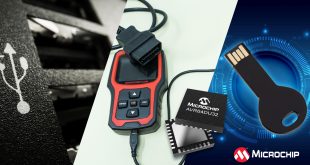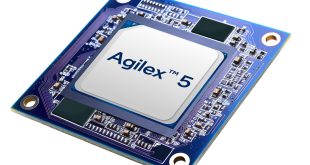 Altera Corporation has announced the availability of non-volatile MAX 10 FPGAs, the latest addition to its Generation 10 portfolio. Using TSMC’s 55 nm embedded flash process technology, MAX 10 FPGAs are set to revolutionize non-volatile FPGAs, according to Altera, by delivering dual-configuration flash, analogue and embedded processing capabilities in a small-form-factor, low-cost, instant-on programmable logic device.
Altera Corporation has announced the availability of non-volatile MAX 10 FPGAs, the latest addition to its Generation 10 portfolio. Using TSMC’s 55 nm embedded flash process technology, MAX 10 FPGAs are set to revolutionize non-volatile FPGAs, according to Altera, by delivering dual-configuration flash, analogue and embedded processing capabilities in a small-form-factor, low-cost, instant-on programmable logic device.
MAX 10 FPGAs are supported by a broad collection of design solutions that accelerate system development, including Quartus II software, evaluation kits, design examples, documentation, training and design services.
“MAX 10 FPGAs address a broad market need to save space, cost, and power by integrating more capability into a single device” said Patrick Dorsey, senior director of product marketing at Altera. “Hundreds of customers in the MAX 10 early access program have already realized the benefits from the combination of high performance programmable logic, analogue, Digital Signal Processing, micro-processor capabilities, and embedded flash technology provided by MAX 10 FPGAs with the Quartus II development software and pre-configured development and evaluation boards.”
MAX 10 FPGAs look to reduce the overall bill-of-material costs while increasing board reliability. The highly integrated, non-volatile FPGAs provide up to 50 percent board area savings compared to other low-cost FPGAs by integrating into a single chip the following key features:
- Up to 50K logic elements
- Flash memory blocks (user flash and dual-configuration flash)
- Analogue-to-digital converters
- Embedded memory and DSP blocks
- DDR3 external memory interfaces
- Embedded processing with soft-core Nios II processors
- Up to 500 user I/O
- Integrated power regulator
These key features provide higher system-level value to customers by enabling MAX 10 FPGAs to perform several important system functions, such as an instant-on configuration, fail-safe upgrades, system monitoring and system control.
MAX 10 FPGAs configure in less than 10 ms (milliseconds) using on-die flash memory. For system management applications, instant-on allows MAX 10 FPGAs to be the first usable device on a system board and control the bring-up of other board components. In data path applications, instant-on allows MAX 10 FPGAs to provide responsive user interaction when powered on.
The on-die flash storage integrated in MAX 10 FPGAs support dual configuration, allowing two FPGA designs in a single chip. The dual-configuration capability enables the device to perform fail-safe upgrades, whereby one flash block is designated for upgrade images while the other block is reserved for a “safe” factory image. This capability enables deployment of systems more quickly, reduces maintenance cost and provides longer operating life.
The analogue blocks integrated with MAX 10 FPGAs include ADCs and temperature sensing diodes. The integrated analogue functionality allows MAX 10 FPGAs to be used in applications that require system monitoring, such as temperature control and touch-panel human-machine interface control. Integrated analogue blocks help to reduce board complexity, lower latency and deliver more flexible sample-sequencing, including 2-channel simultaneous sampling.
MAX 10 FPGAs support the integration of Altera’s soft core Nios II embedded processors, providing embedded developers a single-chip, fully configurable, instant-on processor subsystem. Nios II embedded processors integrated in a MAX 10 FPGA allow the device to be used to efficiently manage complex control systems.
 CIE Components in Electronics
CIE Components in Electronics



